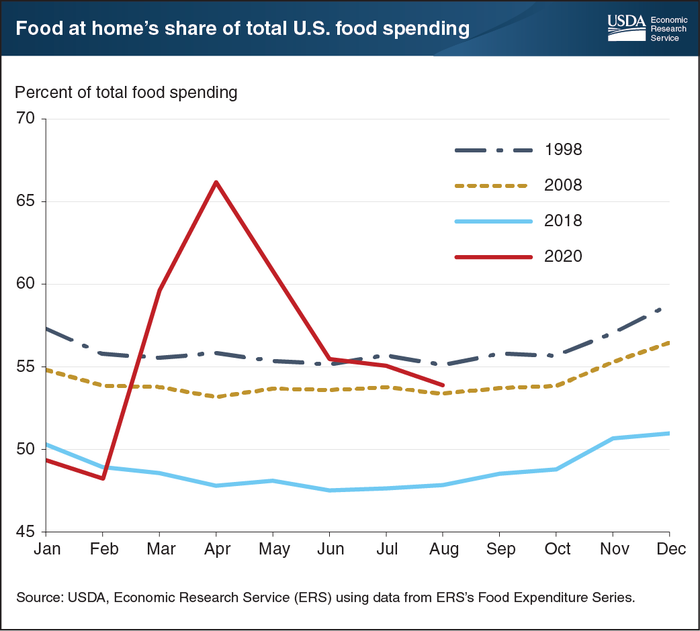6 natural product retail trends to win in 2021 and beyond
These natural retail trends and longtime values deserve boosted attention to keep business moving forward now and into the future.

Talk of natural product retail trends? Is there really such a thing after a pandemic rollercoaster year of rushes and slowness, of safety and health concerns along with some customer bravado, of stocking and supply issue after issue, and of cashflow worries to boot?
What retailer has had a moment to breathe? Not a one.
Not much seems to be changing as we enter 2020. Yet, while that might appear true, the COVID-19 pandemic pushed the future of retail faster than ever into the now. Meeting needs for today and planning for the future remain musts, even during these challenging times.
Here’s a guide to help navigate the natural product retail trends that matter today and post-pandemic.
1. Put a laser focus on convenience.
Any retailer who has heard me speak knows I tout convenience regularly. Those that hadn’t prepared for making shopping as easy as possible for time-starved customers pivoted quickly to make it convenient for shoppers concerned about safety. Over night health food shoppers sought the same services conventional grocers have been practicing (note, I didn’t say perfecting): buy online pick up in store (BOPIS), curbside pickup, delivery.
These omnichannel retailer services alone do not comprise convenience. Retailers must review every step a shopper takes, from planning menus to thinking about shopping to grabbing a cart in the store and maneuvering it through the aisles to checkout and then getting home and unpacking her bags or boxes. How is your natural products store helping along the way? Know your shoppers’ problems and be the one to solve them.
2. Make eating at home easy.
Well before the pandemic one health food store owner I know who prides herself on her prepared foods mentioned finding success in the most boring of offerings. A customer asked if the deli staff could just roast and cut him a handful of chickens and boil a couple of dozen eggs every few days. The young man sought a convenient (there’s that word again) way to meet his high-protein diet without having to meal prep himself. Soon, he sent his friends.
Many food retail customers might be like that young man needing a little help in the kitchen now that the sourdough baking fad has faded and the reality of cooking three meals a day at home and prepping snacks for sometimes the whole family has set in.
The tables have tipped back to eating at home. Before shutdowns changed dining out and safety concerns drove consumers to stay home, consumers spent a majority of their food dollars eating away from home.

This massive shift has changed what’s selling in the center store. How have you adjusted what you stock, how you merchandise it and the services you offer?
Customers need meal solutions across the store. Think meal kits, meal components, precut veggies, marinated meats and ready-to-grill kabobs. What more and different is possible with prepared foods?
Make cooking at home convenient (there’s that word again and again) for shoppers. Two additional macro forces sure to influence home cooking: the minimalism/simplicity movement and frugality. Minimalism has taken hold in fashion and décor. It’s coming to the kitchen as meal prep fatigue sets in, too. And already some data show shoppers turning to value-priced products. This could continue until the economy recovers and school meals again fill some children’s plates once a day.
3. Curate selection for simplicity and differentiation.
What you stock and how you sell it makes you stand out from other food sellers. Curating the in-store selection to serve your niche will be more important than ever in a future that has customers turning to online purchasing for their everyday commodities (that could be from your store, too, mind you) and conventional grocery stores continue to integrate natural brands into their shelves and build natural wellness into their HABA areas.
What’s your store’s purpose? And how does it come to life in product selection, promotion, education and more?
Do you curate for health and well-being? Is your store the place for local goods? Do you cater to healthy gourmands? Do you provide an experience for delight and discovery? Perhaps you offer minimal staples and design the store for special occasion shoppers and those seeking some retail therapy.
Put your focus forward. Retail differentiation is more challenging—but more important—than ever.
Curate and tell your story well to make your natural store’s focus known and obvious. I recently walked a store whose staff and a couple of signs told me of its commitment to local. However, seeing this in the aisles was nearly impossible, and I was looking for it.
Curation and storytelling go hand in hand with mission. Mission-based brands receive so much attention in the natural products industry. Yet those brand stories and store sameness gloss over retailer missions. If mission matters to you, make sure a curated product selection, in-store displays, social media, advertising, community service and so much more clearly celebrate that story.
More and more consumers want to support responsible businesses, and that matters at retail, too. Make the store mission known.
4. Link locale and local movements.
Celebrating local food and farmers has grown from seemingly quaint to commonplace. Yet lessons learned and loss of connection experienced during COVID-19 could renew the great importance of local.
First, a few lessons learned. Long and winding supply chains left some food retailers in a lurch as stockpiling shoppers shifted just-in-time stocking algorithms and often put small retailers behind bigger ones for priority distribution service. Oversized meat processing plants placed workers and meat supply in danger. Divided foodservice and retail food systems left milk, eggs, produce and more dumped. An economy flipped on its head overnight left local businesses behind and the governments and nonprofits they support to struggle from lacking donations and tax dollars.
Local food fills more than a great plate, it feeds the local economy and area residents. Many in business have understood this but consumers haven’t always connected to the whole story. Now is the time to make the message clear, act on it and share it—all in a big way.
Such efforts are part of building local connections, something so many have lost in a year of isolation. Health food stores have long been known for being centers of community, rebuilding those centers in a larger way in a post-pandemic world serves both foot traffic and greater social purpose.
When the coloring book craze swept the country, one natural products retailer found its open coloring night in its café to be the most attended events it offered all year. Imagine the community connection your customers yearn for and find a way to help fill it—when it’s safe, of course.
5. Put health at the heart of it.
A longtime retailer once asked me: Remember when this was the health food industry? I do. And even in the flurry of fads and buzz of social media that sometimes attracts all the attention, health is at the heart of the natural products industry. And it deserves a bigger spotlight as the nation needs stronger foundational health and a focus on wellness.
Interest has grown in recent years. It’s an imperative now.
As the COVID-19 pandemic wore on in 2020, the number of consumers who say they are buying better-for-you products has grown. Early in the year 27% reported such purchasing; in November, 35% percent said they were, according to a New Hope Network NEXT Data and Insights poll. The number focused on natural and organic products also took a large leap from 23% to 31%. Supplement sales are following, too, with an estimated yearly growth rate of 12.1%, according to Nutrition Business Journal.
Health might be central to your natural products store—your mission, story and curated selection building on it. Or it might just be a component, with some health classes and nutritional service offerings. Either way, being of service to customers on their journey to health will help differentiate your store from the conventionals that focus more on the better for you than the best for you.
Consumers seek trusted sources of information, why shouldn’t health food retailers fill that need along with the products to serve it? Once upon a time such stores were the only place to turn. Now social media platforms a plenty provide information. Retailers shouldn’t fear the platforms but use them and be there live and in person as a trusted resource.
6. Adopt a data mindset.
To know your customer and really knowing your customers is a distinction to adopt, if you haven’t already. Natural food retailers connect well with regular shoppers. They talk to them in the aisle and chat up what's current at checkout. Juice bar staff might know a dozen regulars orders from memory. Anecdotes tell the tale of service. Diving into data tells the real story.
Sales data, movement reports, marketing response rates, customer demographics, everything you can pull out of your customer relationship management software … collect the data and, most importantly, use it.
Too many in natural products retailing haven’t even made it to the first step of collecting important information about their customers and their inventory.
Using data does not take the humanity out of natural products retailing. That’s the service so many tout as their winning trait. Instead, it helps retailers understand the people they serve so much better so that they can improve what they offer customers, gain more customers (serve more health to more people) and improve the bottom line.
About the Author
You May Also Like




